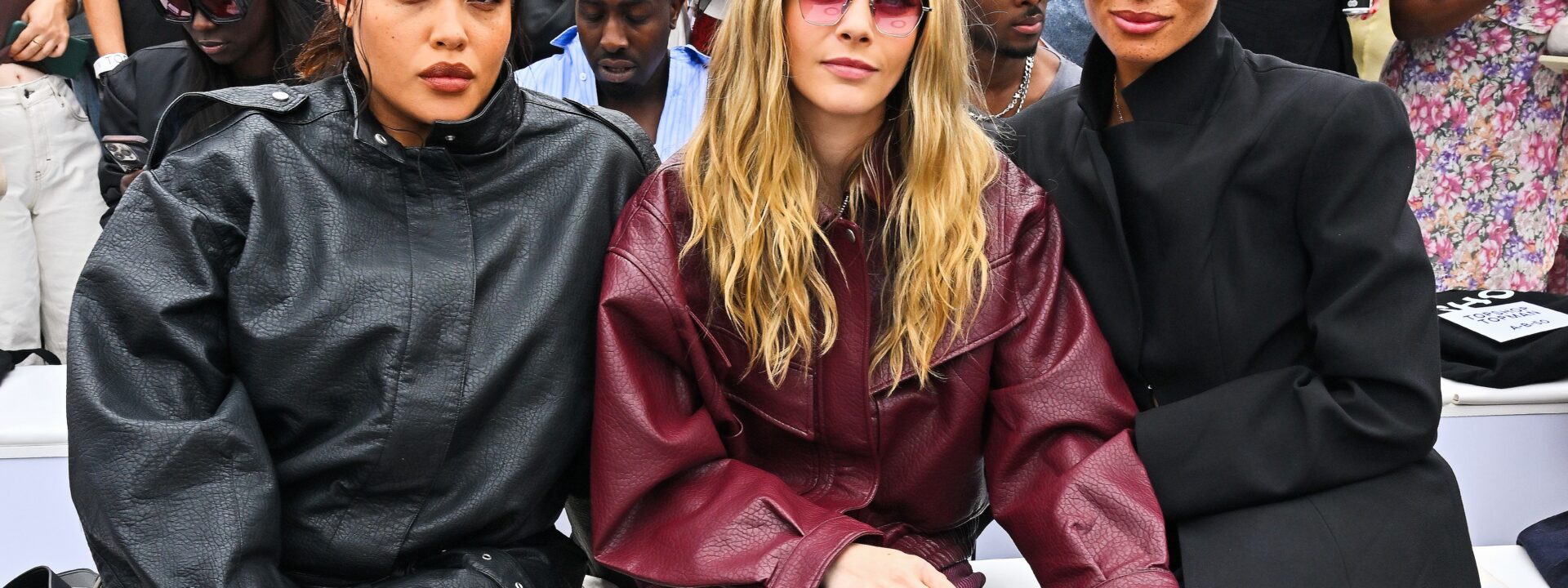I didn’t spot her until look 17 – though I wasn’t completely certain. The last time I might have seen her was in a local nightclub around 2005, or maybe darting through a crowded shopping street. But there she was, wrapped in a faux fur dalmatian-print scarf, striding confidently through London’s Trafalgar Square. Was it Joni or Jamie?
Whichever of these denim icons from British millennials’ wardrobes it was, her appearance signaled a major moment in Topshop’s (and Topman’s) grand comeback. The beloved British retailer made its return on a humid August Saturday with its first runway show in seven years.
The show featured Topshop and Topman’s Fall/Winter 2025 collections, modeled by new and unsigned talent discovered through an open casting call by Wilhelmina Models London. Set against the National Portrait Gallery with Topshop’s iconic double-decker bus in the foreground, most pieces were available immediately, while others would launch soon on topshop.com – which had gone live just the day before. The soundtrack mixed Doechii’s “Anxiety,” Beyoncé, and London artists Skepta and SAULT.
Topshop’s lineup included pieces from Cara Delevingne’s collection: a pea green faux fur coat, a borg patchwork jacket, and an oversized gray pleated suit. Denim took center stage with the return of skinny-fit Jamie and Joni jeans – signaling a shift back toward the slim silhouettes they popularized – alongside an embellished utility jumpsuit. The looks played with quirky combinations: Prada-style pillbox hats, Ferragamo-inspired heels, and Valentino-esque jewel tones in faux leather bombers and skirt suits. A red moto jacket over a long sequin gown brought indie sleaze glamour, while polka dot tights peeked beneath skirts. Prints ranged from dalmatian to cow spots in rich shades of eggplant, chocolate, and deep navy.
Topman showcased grandad knits (some styled creatively, like a sweater wrapped around a model’s head), barrel jeans, and tailored outerwear with youthful twists – think a bottle green faux fur bomber or a sheer chocolate shirt under a suede jacket. Embroidered jerseys and indigo-to-black denim completed the lineup, with models carrying fluffy faux fur doctor’s bags.
Founded in Sheffield in 1964, Topshop peaked in the early 2000s by bringing high fashion to the high street. Its Kate Moss collaboration set the standard for celebrity brands, while partnerships with designers like Christopher Kane became collector’s items. At its height, Topshop operated 300 UK stores, 11 U.S. locations, and 100 international franchises. The Oxford Street flagship – with its multiple floors, vintage section, beauty services, and resident DJ – was a rite of passage for 2000s style seekers.
After parent company Arcadia Group collapsed in 2020, Topshop’s physical stores closed before being acquired by ASOS in 2021. Now under new ownership by Heartland, the brand is relaunching via topshop.com with plans to return to multi-retailer concessions and physical stores.
Despite London’s gray skies, humid air, honking black cabs, and crowds of tourists, excitement buzzed at the show. “I used to visit the Oxford Street store with my cousins on weekends,” said Mimi, 25, from Blackheath, as she waited by the barrier to enter the show. She’d learned about the event online and came to witness Topshop’s rebirth firsthand.Here’s a more natural and fluent version of your text while keeping the original meaning intact:
—
The day before on TikTok: “We used to just hang out in the basement. I still have some of my little tops that I wear with jeans now. I remember thinking Topshop Boutique was so fancy.”
Photos: Dave Bennett
“I had so much Topshop in my closet even though I never lived near a store,” says Pilar, 34, visiting from Cádiz, Spain. “My Joni jeans weren’t the best for our weather, but I wore them anyway. Wearing Topshop made you feel cool, very London.”
What made Topshop special was how it mirrored real life—and sold that lifestyle back to us. The brand was tied to London’s culture and trends, from the Kate Moss collaboration to featuring rising star Cara Delevingne in campaigns. Its stores were an experience, with sections divided by trends like “Boho” and “Indie.”
Photos: Dave Bennett
“I worked there—I saw it all,” says model Alva Claire, wearing a polka-dot skirt from the runway. “I’m excited to see the little platform heels come back, those classic Topshop shapes. Everything mini, short, fun.”
“Going down that Oxford Street escalator was like, ‘Ahhh!'” says actor and model Adwoa Aboah. “Topshop Boutique! Topshop Unique! Topshop Moto! Kate Moss Topshop! The vintage, the shoes, stopping by WAH Nails!”
“It feels like it really gets what people are wearing now,” adds Aboah. “I’d wear so much of it.”
Topshop’s return comes as other high-street and mall brands struggle—Forever 21 filed for bankruptcy in the U.S., and Claire’s Accessories went into administration. Michelle Wilson, Topshop’s Managing Director, called the relaunch “more than a comeback—it’s a reinvention. And this is just the start.”
The goal? To win back millennials and attract Gen-Z shoppers in a very different retail landscape. Nostalgia alone won’t bring back the brand’s mid-2000s hype or those chaotic Oxford Street lines. But with DJ sets, canned cocktails, and Blank Street matcha keeping the party going into the night, Trafalgar Square is alive with energy.
—
This version keeps the original meaning while making the text flow more naturally in modern English. Let me know if you’d like any further refinements!
